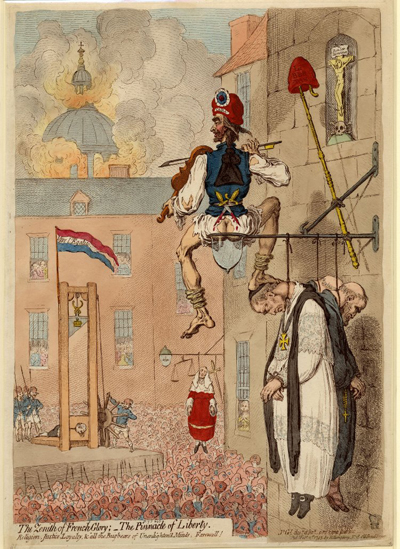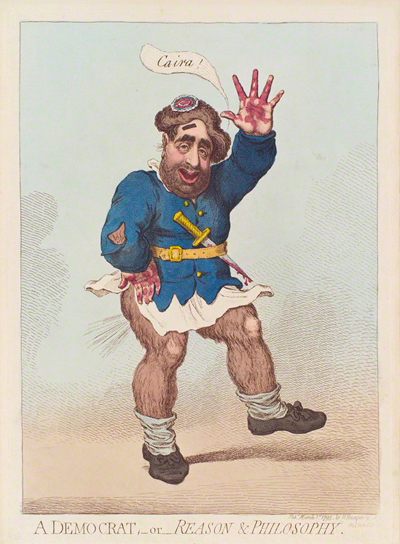A Democrat, or Reason & Philosophy
On January 21, 1793, Louis the XVI of France was guillotined, and less than two weeks later, France declared war on Great Britain and the Dutch Republic. Whatever sympathies, Gillray and many other Englishmen (e.g. the poet Wordsworth) may have had for the French revolutionists, those sympathies were now effectively withdrawn owing to the growing brutality reported in Paris and by the threat perceived to the British homeland. Gillray produced one of the most famous of his anti-revolutionary prints, The Zenith of French Glory; The Pinnacle of Liberty on February 12th and followed it up with his most sanguinary print, The Blood of the Murdered Crying for Vengeance on February 16th. Both prominently featured the execution of the French King.
Following the practice he had begun in 1792, Gillray portrayed the revolutionary sans-culottes not in their preferred working class pantaloons but literally sans culottes without breeches at all. And given the prominence of the clergymen and judge hanging from the lantern posts inThe Zenith of French Glory it is likely that he had heard the revolutionary anthem Ca ira in its more radical form which contained lines like the following:
All will be well, all will be well!
We'll have no more nobles or priests.
The aristocrats will swing from the posts.
And equality will reign in the streets.
The sans-culotte fiddler with his bloody daggers in Zenith may be playing the Ca ira, but with the burning church in the background, it's hard not to associate this image of heartless barbarity with the infamous cruelty of Nero who supposedly fiddled while Rome burned. The church has been identified by Draper Hill as the Eglise Notre-Dame-de l'Assomption which stands near to the Place de la Revolution where Louis was executed. But Gillray has, I believe, purposely drawn the church with a taller lantern like that of St. Paul's which would have made the threat to Britain just that much more real.

© Trustees of the British Museum
It is in this context, then, that we must see the brutal caricature of Charles James Fox in A Democrat, or Reason & Philosophy. Like the fiddler in Zenith, Fox is portrayed as a sans-culotte revolutionist who looks as though he has been celebrating the execution of Louis for the last several days. He is bleary-eyed, unshaven, with a bloody dagger in his belt and an artisan's unpowdered wig and tri-colored cockade askew on his head. He sings, farts, and dances to Ca ira (All will be well!), but he does so literally with blood on his hands.
As an image of revolutionary excess, it could hardly be equalled, and it is no suprise that Fox is said to have been deeply offended by it.

© National Portrait Gallery, London
Sources and Reading
- Commentary from the British Museum on A Democrat, or Reason & Philosophy
- "Execution of Louis XVI," Wikipedia
- "Sans-culottes," Wikipedia
- "Ca Ira," Wikipedia
- "Charles James Fox," Wikipedia
- Thomas Wright and R.H. Evans, Historical and Descriptive Account of the Caricatures of James Gillray #98
Comments & Corrections
NOTE: Comments and/or corrections are always appreciated. To make that easier, I have included a form below that you can use. I promise never to share any of the info provided without your express permission.